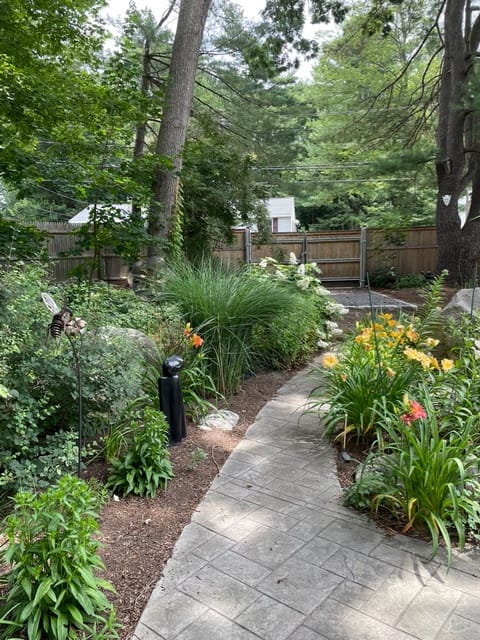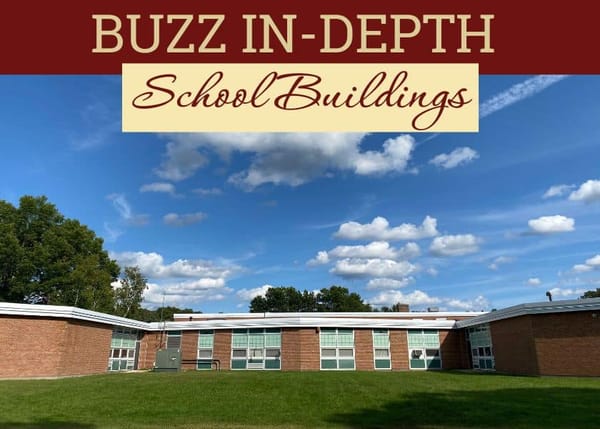A Recognized Wildlife Habitat Right Here in Burlington
Plants & Animals Column #3



My wife, Jane, and I love wildlife. We have always observed and encouraged all wildlife in our yard, and we enjoy spending time with the variety of organisms—from bees to raccoons—that come to feed, drink, rest, and raise their young here. When we read about the National Wildlife Federation’s Certified Wildlife Challenge in their magazine, it provided a means to verify and validate the things we were already doing. We applied, and now our yard is a National Wildlife Federation Certified Wildlife Habitat!
We proudly display plaques of recognition both outside and inside of our yard. As the plaque states, to be certified, the property must sustainably provide four habitat elements: food, water, cover, and places to raise young. Learn more
Supporting a Certified Wildlife Habitat
Food
We offer a widely varied menu: a post feeder with small seed mix; a platform feeder under that frequented by mourning doves, cardinals, and blue jays; a suet feeder popular with nuthatches and squirrels; a hanging feeder with black oil sunflower seeds primarily for our red squirrels and flying squirrels (who have come to that feeder almost every single night for years); another small hanging feeder with a woodpecker mix. In the winter Jane smears peanut butter onto the bark crevices on some trees. The squirrels love it! We also supply hummingbird feeders in spring and summer.
In addition to feeders, many plants provide food. Cone flowers are a huge hit for goldfinches in the fall; we grow three different types of milkweeds for butterflies. Winterberries are beautiful in the winter until, in early spring, the robins show up and strip all the berries in a day or two.
All summer long our yard is alive with thousands of bees, wasps, and other flying insects feeding on nectar from scores of flowering plants, both native and non-native. To many of you, this might sound terrifying. However, most wasp species are solitary, non-stinging types that prey on other insects. Honeybees are docile insects that die if they sting—they do not sting except as a very last resort to protect the hive. Remember, without pollinators, we would have no flowers or fruits!
Honeysuckle, Jacob Cline beebalm, and “Lucifer” Crocosmia are all bright red and are hummingbird favorites, as is our “orange hummingbird mint,” Agastache. Our crabapple tree is over 50 years old and still gets heavy with flowers and fruits. We let the hundreds of little crabapples stay on the ground when they fall, and nearly every single one is eaten by deer, crows, blue jays, and others.
Water
We have several water sources, including a large rock with a depression that makes a natural birdbath and a heated birdbath which in the winter is frequented by birds, squirrels, chipmunks, and even our honeybees when they come out for exercise on a warm winter day. We also have a water feature that bubbles water down stone pillars, which birds use for drinking and bathing, and a shallow tray of water mostly for the honeybees from our hives to drink. (Making honey requires a good amount of water!)
We promote native plants, but we do plant some non-native flowers just for beauty, being careful to avoid invasive species. The hardy Chinese Ground Orchid is probably my favorite plant in the yard. Its dramatic display of bright purple flowers in June lasts for weeks, each tiny flower a perfect little orchid.





Burlington's very own Certified Wildlife Habitat. Click each picture for a description. Photos courtesy of Bill Boivin.
Cover, Shelter, Places to Raise Young
Our yard provides a wide variety of housing. Our bird houses are of different sizes and shapes: some small and hanging; some fastened to trees, posts, and fences; several mounted directly on our house. We have bat houses, a toad house, a flying squirrel house, and a wood block with small, pre-drilled holes specifically used by mason bees who lay one egg in each hole with a food supply of pollen and then seal it up with mud. Hatchlings chew their way out.
When the leaves fall in autumn, we let them stay on the ground in all our flower and shrub gardens and remove them in the spring. (Some areas we never rake up.) Many insects overwinter under leaf litter and inside hollow dry plant stems. Evergreens, especially dense ones, provide important winter shelter for small birds.
We also have a small brush pile in a corner of our yard, used mostly by small birds for shelter. It’s just sticks, twigs, and small branches started each spring and left through the winter. We clean it up each spring and start again.
Snags
Tree “snags” are the remaining stumps of trees that have fallen or been cut. More than just a stump, a snag is usually 6 to 10 feet tall. This snag can then do one of two things…it can grow new sprouts and become a shorter version of its native self, or, if dead, it can decay. We never remove a healthy tree for any reason, and we always leave snags whenever a tree must be removed in our yard.
Above, you can see two of our tree snags. In one, the top of the tree had split off in an ice storm. Though not dead, it was unsafe. We placed a bird house on top of the snag and then watched as new sprouts created a living piece of art complete with a 4-bedroom apartment complex.
The other snag was that of a dead tree, cut and left for nature. The natural process of decay involves the efforts of bacteria, fungi, insects, birds, and other animals. This, together with the collective effort of a myriad of other living creatures, eventually created a cavity large enough for a mother raccoon to raise a litter.
People tell me, “I want a big lawn for my kids to play on.” Trust me, your kids would rather explore a mixed environment than run around on a lawn. I look at a blank lawn as a palette to be painted. Forcing it to look a particular groomed way such as a monoculture lawn requires constant suppression of that natural system.
Look at your property as one single living organism. Each species of plant or animal is like a separate cell or organ. Mosquitoes feed the dragon flies; dragon flies feed the birds; birds droppings, broken eggs and dead babies feed the beetles, trees and plants. Because of its limited size, you might need to help by providing supplemental food, water and shelter, but if you let it work naturally, your yard can thrive without using pesticides or chemicals. Don’t look at yourself as overlord of your yard but as one of the many species living within it. The more mixture and opportunity you provide on your property, the more wildlife it can support. A diverse environment is a healthier, stable environment more resistant to disease, invasive species, and climate change. And, it’s a heck of a lot more interesting!
Bill Boivin is a scientist, retired from 30 years of active duty with the United States Public Health Service. He is a Burlington Town Meeting Member and Conservation Commissioner. He and his wife, Jane, grew up in Lynn and now live in Burlington with their 2 mini dachshunds, 7 chickens, and Maya, a ball python. Bill and Jane have shared a love of nature, gardening, and wildlife for over 50 years. They have fostered, healed, raised, and loved a remarkable variety of animals in their time together. Learn more about Bill




